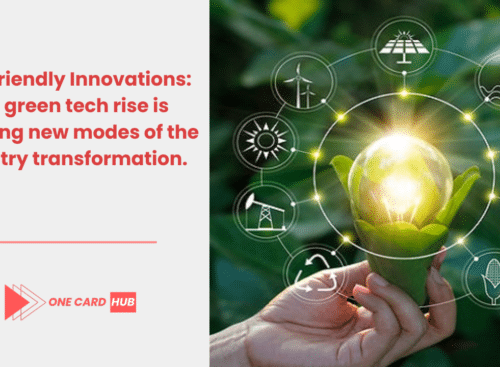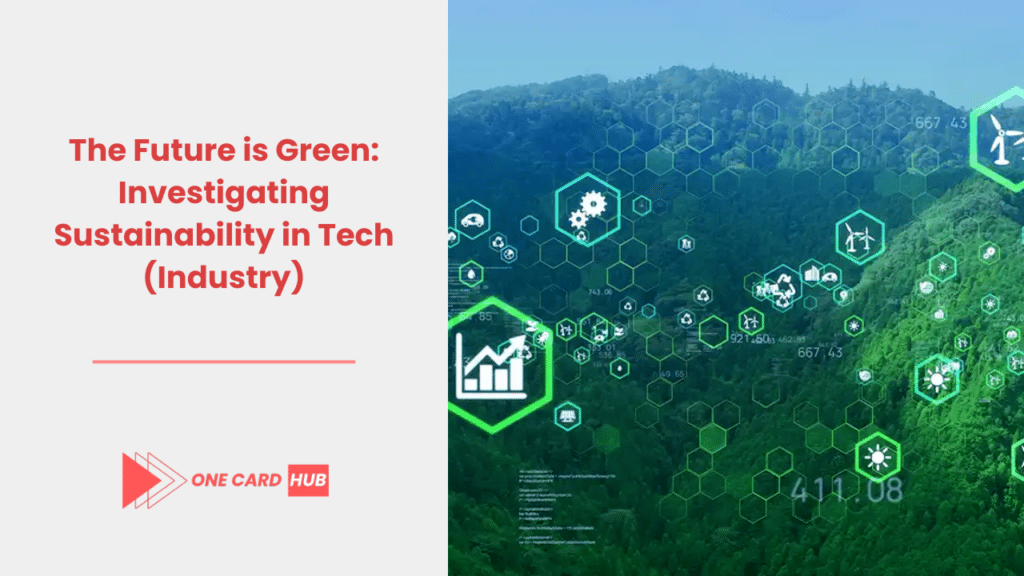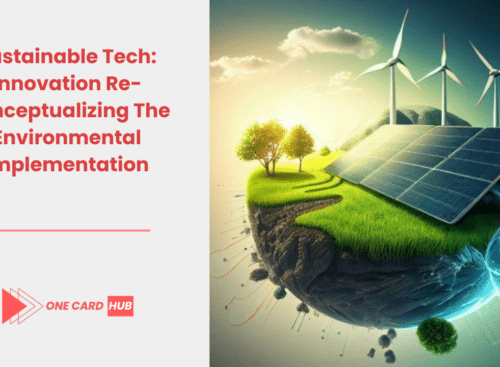The industry of technology has been the subject of intense scrutiny by a number of members of the society as of late, due to the growing environmental issues it cause. Data-hungry data centers to electronic devices recycling issues by zeros all the way to the downside faced by the digital revolution are some of the issues the digital world is facing as a whole. Nonetheless, the industry increasingly embraces the notion of a reconciliation between ecological consciousness and technology. This transition to green technology however is not just a remedy for the harm already caused to our planet. What it is is a long-term strategy for leveraging the potential of technology to help us create a sustainable world where the role technology plays in environmental change is appreciated.
Rethinking Energy Consumption
With the data center energy which powers the cloud computing as well as our email communications among the most strategic points to be focused is the data center energy itself. Just like Google and Apple, which already have fully renewable energy sources for their data processing, other companies should definitely use cleaner energy sources as well. This comprises establishing electric systems for their own buildings, including installation of solar panels and wind turbines that ensure that utility is derived even from new energy sources which helps the development of the renewable energy sector within this region.
Besides, growth of demand for more energy-efficient hardware is rising in strength. Improvements of integrated circuit technology, like low power chips development offering, allows the generation of equipments that can function without a noticeable efficiency drop at lesser power consumption.
Embracing the Circular Economy
The IT-industry is notorious for quick product cycles, which result in not only a great deal of waste, but also in high costs to consumers, which would be significantly reduced with better product lifecycle management. Nevertheless, a regenerative economy — characterized by sustainable consumption and production principles, thusly, a lowering, reuse, and lifecycle recycling of materials — is gradually getting embraced. Products are more and more manufactured by companies in order to achieve encorporating their life span that make them easier to be stripped and recycled at the end. Initiatives such as the introduction of the robot Daisy, which can disassemble iPhones to recover valuable materials by Apple, underline the possibility of technology being used as accelerater of sustainability. Improving the presence and motivation of surveillance in utilities, banking, agriculture, transport, and the media have had a positive impact on the fight against corruption.
Moreover, the emergence of platform providing the repair, refabrication, and resale of the electronic devices is one of the consequent factors which helped in increasing the lifespan of the products. The pollution is as well diminished, hence the consumers of technology get something more affordable. It is one way of closing the digital divide.
Tech being one of key resources for resolving Global warming and other environmental issues.
What is more, above all else, tech companies is in the position of creating eco-friendly solutions for wider environmental problems. Irrespective of the sector, from energy-saving algorithms in buildings to the capabilities of putting data about supply chains on the blockchain, environmentally-friendly technology is being used in virtually all types of businesses to promote sustainability.
One of today's likely outcomes is a revolution in areas concerned with fighting climate change. Deforestation, for example, is being surveilled via satellite imagery and massive data analytics. It's being monitored and the state of wildlife populations is being tracked, and, most importantly, so is the prediction of natural disasters, making conservation a more efficient process.
The Path Forward
The path to a cleaner tomorrow has a multi-faceted character which asks for collaboration of tech firms, consumers and the government. The main concepts of such policies are decoupling from production growth as well as investing into technologies that lead to environment protection. With respect to the future worldview, the assertion of green principles in the chemistry of the technology industry would lead to a parallel of the success and sustainability of human beings.
Such commitment to sustainable tech, recently, is not a fashionable yet inevitable innovation stage. Energy efficiency can be highly improved by advocating for it. Moreover, we should take models that employ the cyclic economic approach and leverage technology in favor of green solutions to pave a way to the future, which is both advanced technologically and green. However, as we employ the crafts of technology to unlock the limitless opportunities in digital arena, it's crucial that our era of technology and digital world are indicative of sustainability in the society, ensuring a better environment and the well-being of future generations we will leave behind.
Sustainability Policies and Formulations
The recognition of the policy role by national authorities and regulatory institutions is playing an increasing part in the myriad of issues related to tech industry sustainability. Initiatives such as Europe’s Green Deal, which aims to ensure that by 2050 Europe is the first climate-neutral continent, is an example as it includes dedicated strategies for a digital transition that is also sustainable. In the same manner, policies that promote enhanced producer responsibility in the sense of the extended producer responsibility (EPR) ease the burden of the electronics’ manufacturers as they should bear a required share of accountability for the processing of their products at the end of their life cycles, which is likely to result in better sustainable designs of the electronics.
Consumer Power and Sustainable Options: The way consumer spend their money can make a big difference in determining the types of products available on the market.
The consumers make up the very largest chunk of the market - therefore, they are the ones driving the demand for sustainable technology. Consumers with knowingness and demand for environmentally sustainable goods persuade the companies to include less harmful practices on the priority list. Ethical consumerism has turned to be an inventive force especially in making products for their sustainability which range from smart phones made from fair-trade materials and have improved aesthetics to apps designed to help users reduce carbon footprint.
The Role of Innovative Agencies and Start-ups in Environmental Management
Innovation is the core of tech industry and startups usually are the creations of the technologies having latest Green technologies. You know what is a new battery technology? This one is a more efficient, clean存储 solution that will come to the green technology space. Another innovation is agricultural technologythat not only will reduce water usage but also will increase crop yields. A green tech fundraising with VCs’ participation is swelling which accentuates the belief of this market that sustainable products have a great potential.
Education and Awareness
The education and awareness step comprises a crucial part of developing a sustainable future in the technological sphere. The number of people who are becoming
informed about the environmental footprint of their electronic lifestyle is on the rise and more people are becoming proponents for change. Education programmes stressing the sustainability of technology in every new gadget may inspire the new generation of invention makers who would make environmental solutions available from the start.
A Green Horizon
Without a doubt, a vital component of technology is green. Not only in the era of advanced technology, but also in environmental concerns, sustainable practices for the tech industry will not recognize as a response strategy, but it is essential for companies to keep running. Through incorporating the sustainability agenda into all aspects of technology engineering - from Research and Development to the end of its lifespan - we can meet a future where the two factors – technology advancement and environmental care - are aligned. The path towards a resource-friendly tech sector is though and needs on-going progress, freshness of thinking and team work. Nevertheless, we cannot deny that the ecological benefits for our environment and society represent the path to a much-heralded future. We can make life easier and greener for subsequent generations by adopting the best green technology now.
FAQ: Sustainable Approaches for the Technology Trade.
Q1: What is the meaning of this green technology term?
A1: Environmental technologies or green tech are the products and processes that create the least possible impact on the environment including their production, functioning, and end-of life cycle. The program's main objective is cutting down on greenhouse gas emission by creating less waste and pollution, and of course, use resources in a more effective way.
Q2: What is the reason behind the eco friendly approach in the tech companies?
A2: Sustainability is vital in the tech industry to minimize waste, pollutions, energy use and carbon emissions generated respectively from electronic products manufacturing, data centers consuming, and overall infrastructures of tech industry. That is the way to keep up the development of the industry which doesn't ruin natural resources or the environment.
Q3: Company - Technological sustainability: How are tech companies systematically becoming more sustainable?
A3: With energy sources such renewables for data centers, more tech companies are trying to focus on sustainability. These companies are working on technologies for devices which are easy to recycle indeed and investing in energy-efficient technology. Also, they are promoting circular economy through refurbishing and recycling the devices at fixed interval of time.
Q4: What is the circular economy and how does it map for technology?
A4: The circular economy is an ecological strategy of industrial manufacturing, which envisions a zero waste production and continuous reuse of materials. In technology area, this entails making things to last longer, let them be repaired and reused if possible, and the recycling of the materials after the lifespan.
Q5: Is it consumers who can propel the tech industry from being antagonizing towards green practices?
A5: Customers, indeed, have a crucial part to play in their buying behaviour, where they choose to purchase more eco-friendly products and also to work with brands that have environmental conservation in their vision. As consumer preferences move to greener preferences, companies can be driven to adopt green practices and formulating earth friendly products?
Q6: Sustainable technologies can be defined as environmentally friendly or energy-saving technologies which are widely used in our modern world.
A6: Sustainable technologies comprise of solar panels or wind turbine for clean energy resources, power-saving LED light, batteries for the electric car, eco-friendly biomaterials for producing devices, software solutions that enhance the energy utilization in buildings and transportation.
Q7: AI application fields are manyfold. One of the most striking examples is the use of AI in improving tech sustainability.
A7: AI is being exploited in the energy sector after all to realize maximum savings and efficient use of resources for improved environmental protection. AI can forecast energy demand to prevent squander, differentiate trends in environmental data and trace climate steadiness, and effectively manage supply chains' to reduce carbon footprints.
Q8: What obstacles the tech sector has roofing over now, in order to manage to be more environmentally friendly?
A8: The hurdles that this transition might face are the hefty cost of transitioning to renewable energy, the design and fabrication complexity of products for repairability and recyclability, standardization demands on managing e-waste, especially on the global level, and the demand of continuous innovation that does not compromise on environmental sustainability.
Q9: In a manner of consumer how do I can take part in a blueprint of a sustainable world in the field of technology?
A9: Consumers can be engaged by buying from companies that promote sustainability and recycling of their devices in proper ways from markets, choosing refurbished devices, smartphone settings management for power conservation and campaigning for greener policies and practices.
Q10: In the tomorrow's world sustainable technology and the tech industry itself?
A10: The future outlook is positive with more enterprises taking sustainability goals, the emergence of green technology innovations, and the demand from consumers rising of eco-friendly goods and still there is the support for clean technology all those can be taken as an example. Digital industry is shifting towards the model where development and surrounding environment remain fully sustainable in the long run. These concepts are driving the digital economy to become diverse and inclusive.





Related posts